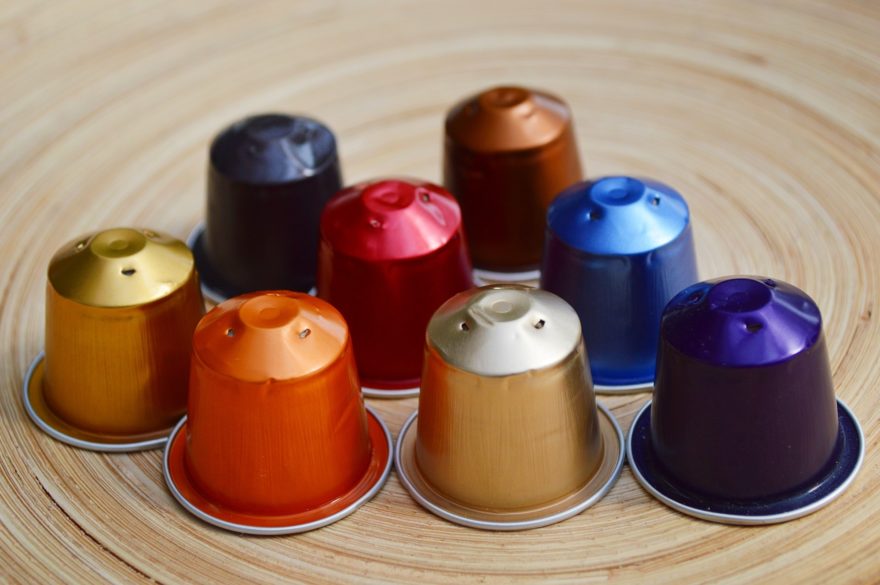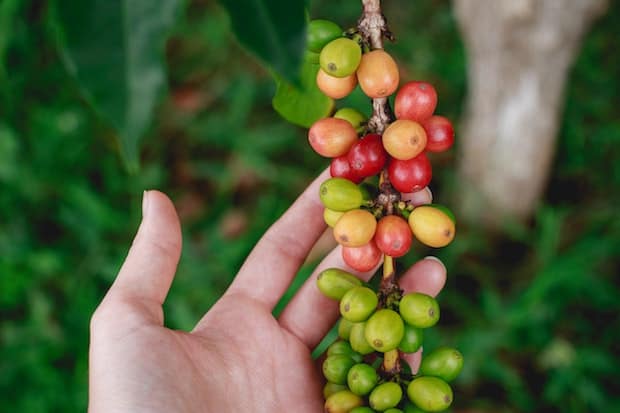Last Updated on November 5, 2023
Capsule coffee machines continue to be increasingly popular in homes worldwide, lauded for their efficiency and ease of use. These convenient coffee brewing systems come with understandable questions around waste and sustainability.
Nespresso, one of the pioneers and current top brands, is attempting to move the industry toward a more sustainable future with their AAA Sustainability initiative.
I was skeptical, wondering if this was yet another corporate greenwashing scheme, but I was surprised to discover that Nespresso is actually taking meaningful and measurable steps toward a more environmentally and socially responsible business model. Through investigation of their most recent Creating Shared Value Reports, supported by several independent studies, I found that those popular Nespresso machines—although far from perfect—aren’t as problematic as I thought. And the parent company appears truly committed to a sustainable future.
The greatest concern around capsule coffee machines is the waste, so let’s examine the initiatives behind recycling Nespresso pods before diving more deeply into the overall sustainability of owning a Nespresso machine.

How to recycle Nespresso capsules
In the U.S. and Canada, there is a simple and fairly accessible Nespresso bag system. Nespresso sends you a recycling bag free of charge with all online orders. You can pick up bags at any retail outlet as well. Where you go from there depends on where you live. The bags come in different colors depending on how they are to be collected. The Nespresso website is clear and concise. It guides you through the recycling process for your area.
In the U.S., you can bring your bag of used capsules to any Nespresso retail outlet or UPS drop-off, or simply leave your bag for pickup if you have other UPS parcels going out (black bag).
In Canada, you can pop your bag into any Canada Post mailbox (red bag).
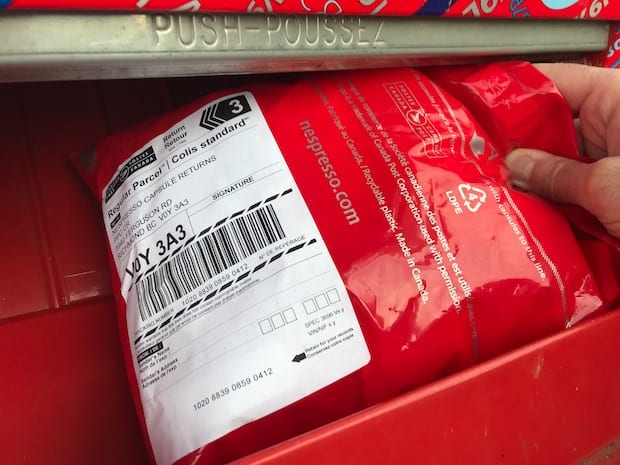
In some areas, you can put your bag of used capsules directly into your municipal recycling container (green bag).
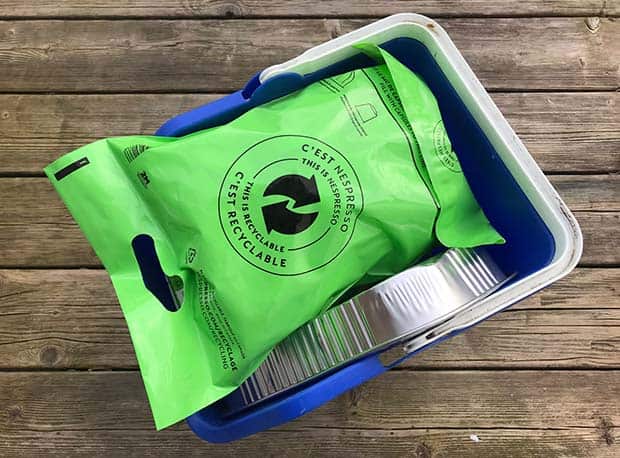
A new initiative in New York City allows residents to throw their capsules right in with their regular household recycling. That initiative saw Nespresso invest $1.2 million in municipal recycling centers to upgrade and install machinery that can sort small pieces of metal. Capturing and processing small pieces of metal is the most difficult step in recycling coffee capsules, and why most have to be kept separate from other household recyclables for shipping to specialized facilities.
It’s a PR boon for Nespresso, but it does show a necessary move toward manufacturer-based recycling responsibility—something that should be the norm but too often is passed on to the consumer. It also allows the world’s most wasteful city to capture and recycle far more small pieces of metal of all kinds, which is a major plus. Other big cities should push for it as well.
The bad news about Nespresso pod recycling
The bad news comes in the form of the dismally low number of capsules that are actually being recycled, estimated at only about 30 per cent (Nespresso CSVR, 2019). This shockingly poor performance is likely due to a combination of:
- poor access to convenient recycling options in some markets and remote areas
- low levels of overall awareness
Nespresso is trying to address both, and their collaborations across the industry—such as opening their facilities to other brands as well—shows their commitment to industry-wide change and reducing environmental impact.
However, recycling of aluminum coffee capsules needs to reach a much higher threshold. If Nespresso really wants to claim a sustainable business model, then they also need to implement programs for recycling the coffee machines themselves (Marcovecchio & Nambalirwa, 2017).
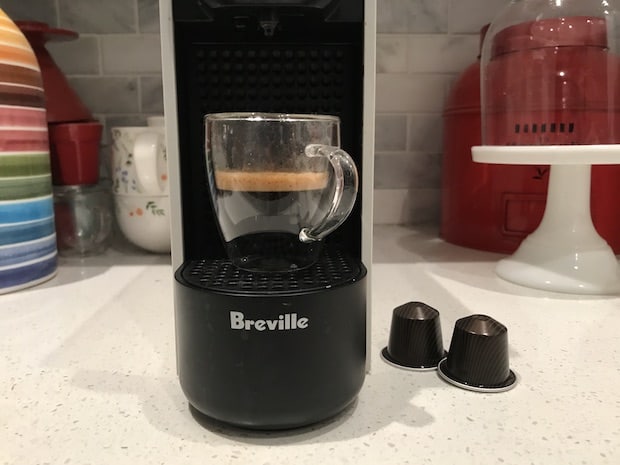
What happens to used Nespresso capsules?
In most regions, your Nespresso capsules go to a specialized recycling facility that can efficiently break down and process small pieces of metal. The used coffee grounds are separated from the aluminum, and each is sent to the appropriate facility for further processing.
The coffee grounds are turned into nutrient-rich compost. The aluminum is turned into future aluminum products—from soda cans to fancy pens, to the somewhat gimmicky but undeniably stylish new RE:CYCLE from innovative Swedish bicycle company Vélosophy. Nespresso partnered with Vélosophy on the RE:CYCLE, which is a trendy bicycle with a frame made from the aluminum of 300 spent Nespresso capsules. It sells for around $1,500, which might seem pricey for an everyday cruiser, but it’s on par for a bike of its quality and function.
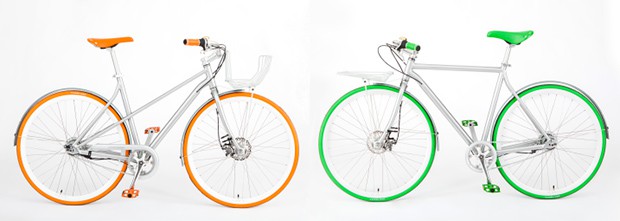
Nespresso recently began incorporating the used aluminum from capsule recycling back into their production stream in an attempt to further close the loop and support their lofty sustainability commitments. They aim to have 80 per cent of aluminum for capsule production coming from recycled sources by the end of 2021 (Nespresso CSVR, 2019).
This is a necessary step forward. Although aluminum is essentially endlessly recyclable, the mining of bauxite for aluminum production is both resource-intensive and environmentally harmful. The steep increase in aluminum usage due to coffee capsules requires a move toward a closed-loop system, and we can’t ignore the fact that recycling still requires a lot of energy and generates waste of its own (Marcovecchio & Nambalirwa, 2017).
Are Nespresso machines sustainable?
Nespresso still has some work to do on recycling access, but the brand has created a robust and easy-to-navigate custom recycling program for their capsules. They’re working to incorporate more recycled aluminum into their capsules each year, and are committed to net-zero emissions by 2050 (Nespresso CSVR, 2019).
Is using a Nespresso machine a sustainable choice overall? To my own surprise, it turns out that yes, it actually can be.
Coffee consumption inherently has a large footprint, so unless you’re willing to give the stuff up (fat chance of that), we must accept that it is a resource-intensive and waste-generating product. There are, however, ways to reduce our footprint. If we try to analyze the carbon footprint of our daily cup of coffee, some factors are going to be beyond our scope of knowledge, but there are still several metrics that can help us estimate it. Packaging waste is actually one of the smallest concerns in the coffee sector.
Production
The farming of coffee beans accounts for 21 per cent of the overall carbon footprint of our coffee consumption. Fertilizer use is the main factor (Killian, et al; 2013). Sustainable production methods such as shade growing and waterway buffering have the least impact, but they are also the most expensive and difficult to find. You can almost guarantee your local coffee shop isn’t using these quality coffees for their espresso-based drinks.
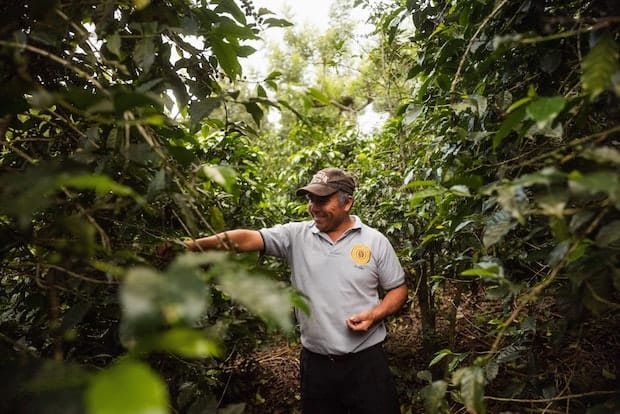
Fair trade coffee is a great place to start, and can now be widely found throughout the marketplace. Not only does Fairtrade International ensure that coffee farmers are being paid a fair and competitive price for their product, it also requires growers to actively improve their local ecosystems rather than harm them. Fairtrade products must meet these standards to be considered for the program, which is supported through education and additional funding.
Nespresso has a few Fairtrade-certified coffees on offer, but they also have their own in-house AAA Sustainability program that supports small-scale coffee producers, with a particular focus on war-torn and otherwise marginalized areas and communities.
The AAA Sustainability Initiative was developed in partnership with the Rainforest Alliance and built on the three pillars of quality, productivity, and social and environmental sustainability (Nespresso CSVR, 2019).
I questioned the efficacy of this coffee sourcing program, but I was impressed to find that the plan is robust, actionable and accountable. Now, 95 per cent of Nespresso’s coffee comes through the AAA program, but only 56 per cent is certified Fairtrade or Rainforest Alliance-approved. Given Nespresso’s large share of the market, if the remaining 44 per cent is coming from more conventional farming methods then they are still likely contributing to environmental decline, and carbon emissions from extensive fertilizer use in some areas (Marcovecchio & Nambalirwa, 2017).
Until their AAA program is 100-per-cent certified it will remain difficult to accurately measure the overall impact of Nespresso’s coffee production.
Processing
We think of coffee as a bean, but it’s actually a fruit. The bean is that fruit’s seed.
When coffee beans leave the farm they are still in their “cherry” form and must undergo a milling process to remove the cherry, which includes pulping, hulling, and polishing. The predominant milling approach is wet milling, which produces a more consistent, higher quality, market-ready bean (Subedi; 2010). However, this process is responsible for a whopping 10 per cent of our coffee’s overall carbon footprint, resulting mainly from the huge volume of water used and wastewater produced (Killian, et al; 2013).
The dry milling process, although more sustainable, requires long periods of dry and sunny weather. It tends to produce beans that aren’t of high enough quality for the export market (Subedi; 2010). Without a viable alternative to wet milling, we may be stuck eating (or more aptly drinking) this chunk of our coffee footprint for the foreseeable future.
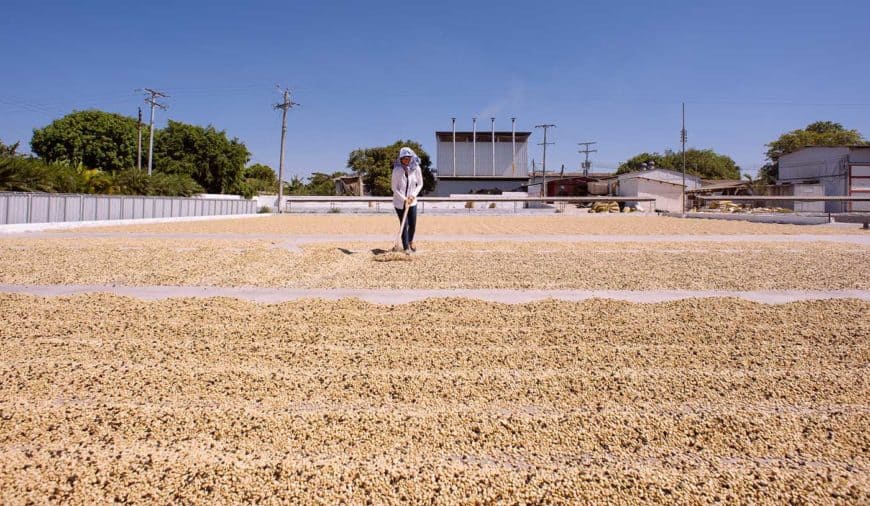
It is the overall umbrella of consumption, however, that accounts for the largest portion of our coffee footprint. Fortunately, it is also one area where we have more control.
Consumption
The consumption phase of the coffee supply chain accounts for 63 per cent of our coffee’s footprint. Here’s how our coffee consumption carbon footprint breaks down:
| Process | % of total footprint |
|---|---|
| Brewing | 45% |
| Grinding and purchasing | 6% |
| Roasting | 4% |
| Packaging | 3% |
| Distribution | 3% |
| Disposal | 3% |
As consumers, we have little influence over many of these factors, but luckily the biggest culprit—the brewing method—is one area where we can make a daily choice.
Buying a coffee shop latte or cappuccino with regular cow’s milk is going to have the largest footprint:
- The beans are likely mass-produced, as most coffee shops are unlikely to use high-end beans for espresso.
- Dairy production, as we know, emits a lot of greenhouse gas.
- Commercial espresso machines use more energy and water than any other brewing device.
- Coffee shops, by their very nature, consume more energy to run all day than your kitchen does.
So drinking your coffee at home is already a more sustainable option.
When it comes to home brewing, single-serve capsule machines actually win out over many other brew methods because they flash-heat only what is needed and turn off when they aren’t in use. This conserves water.
Compare that to a drip coffee machine, which not only brews a whole pot of coffee that might not even get completely consumed, but likely stays on for several hours to keep that coffee warm. Nespresso machines heat up in 20-30 seconds, brew your coffee in less than a minute, and shut themselves off shortly after.
Unplug your machine when it’s not in use to further reduce “vampire” energy consumption. (Your appliances continuously draw small amounts of energy when they’re plugged in.) Your kitchen may not have the same ambience, but if sustainability in your coffee routine is important to you, reduce your trips to the local cafe.
A Nespresso machine can make a latte or almost any other delicious espresso-based drink for you to enjoy at home. And Nespresso provides good value.
Final thoughts on Nespresso’s sustainability
Is Nespresso a perfect company? No.
Is their parent company Nestlé known for dubious business practices? Yes.
They are, however, making impressive and traceable steps toward a more sustainable future, and becoming leaders in the coffee industry.
It’s easy to get hung up on capsule waste, but we often overlook the much larger unseen environmental costs of coffee, such as water and energy use.
Nespresso should be examining innovative waste solutions. Moving to compostable capsules should be on their radar, if it’s not already. Should they stick with aluminum capsules, nothing short of 100-per-cent waste capture and recycled aluminum use in the coming years should be viewed as acceptable.
I was personally quite surprised to discover the overall low impact of these flash-brew methods, something I truly hadn’t considered before. As someone who greatly values a sustainable lifestyle, I’m actually quite impressed with Nespresso’s sustainability models and commitment within the industry. Their new Creating Shared Value reporting is a step toward transparency, and I was pleased to see that they were open about where they were falling short on goals.
Overall transparency in reporting, however, is something that still needs significant work if they are truly to position themselves as a company that’s committed to sustainability in coffee.
Sources:
Creating Shared Value Report, 2019 Status and 2020 Outlook, (2020). Available online: https://sustainability.nespresso.com/sites/site.prod.sustainability.nespresso.com/files/Nespresso-CSV-2019-Status-and-2020-Outlook-Report.pdf
Marcovecchio, Hernán & Nambalirwa, Kawuma Pamela, (2017). “Sustainability-centred business model innovation: Learnings from and insights into how sustainability has affected the business models of Nespresso and Starbucks.” Available online: https://lup.lub.lu.se/student-papers/search/publication/8917350
Killian, Bernard; Rivera, Lloyd; Soto, Melissa; and Navichoc, David, (2013). “Carbon Footprint across the Coffee Supply Chain: The Case of Costa Rican Coffee,” Journal of Agricultural Science and Technology, B3, 151-170. Available online: http://www.davidpublisher.org/Public/uploads/Contribute/55d17d4c702dc.pdf
Subedi, Raghu Nath, (2010). “Comparative Analysis of Dry and Wet Processing of Coffee with Respect to Quality in Kavre District, Nepal.” Larenstein University of Professional Education. Available online: https://edepot.wur.nl/166282

